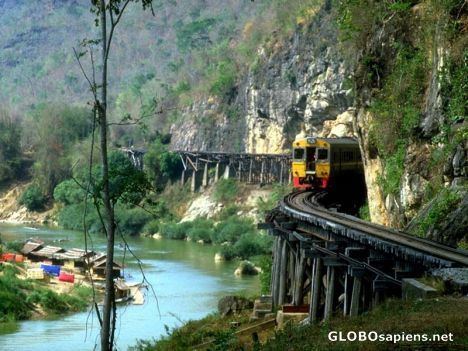Time zone ICT (UTC+7) | Elevation 100 ft (30 m) Population 172,373 (2000) | |
 | ||
District Amphoe Mueang Kanchanaburi Weather 29°C, Wind SW at 3 km/h, 70% Humidity Points of interest JEATH War Museum, Mueang Sing Historical, Thailand–Burma Railway Museum, Erawan National Park, Burma Railway | ||
8 top attractions in kanchanaburi you should visit
Kanchanaburi (Thai: กาญจนบุรี (Pronunciation)) is a town municipality (thesaban mueang) in the west of Thailand and part of Kanchanaburi Province. In 2006 it had a population of 31,327. The town covers the complete tambon Ban Nuea and Ban Tai and parts of Pak Phraek and Tha Makham, all of Mueang Kanchanaburi district, and parts of the tambon Tha Lo of Tha Muang district. Kanchanaburi lies 123 km west of Bangkok.
Contents
- 8 top attractions in kanchanaburi you should visit
- Map of Kanchanaburi Thailand
- Kanchanaburi city video guide
- History
- Climate
- Location
- Buddhism
- Death railway
- References
Map of Kanchanaburi, Thailand
Kanchanaburi city video guide
History
In the late 18th century, Kanchanaburi was established by King Rama I as a defensive outpost against possible Burmese attacks in what is now Lat Ya subdistrict. In 1833, the town was moved about 16 km towards the south-east along the river to its present site during the reign of King Rama III.
Climate
Kanchanaburi has a tropical savanna climate (Köppen climate classification Aw). Winters are dry and very warm. Temperatures rise until April, which is very hot with the average daily maximum at 38.2 °C (100.8 °F). The monsoon season runs from May through October, with heavy rain and somewhat cooler temperatures during the day, although nights remain warm.
Location
Kanchanaburi, which is where the Khwae Noi and Khwae Yai Rivers converge into the Mae Klong River, spans the northern banks of the river and is a popular spot for travelers. Its location at the edge of a mountain range keeps it much cooler than the other provinces of central Thailand. The city has two major commercial districts: the downtown area consists of a grid of several streets with office buildings, shop fronts, and a shopping mall; and the riverfront area businesses are mostly further west along River Kwai Road. Once a year a carnival comes to town and is set up in the area next to the bridge. At night there is a small pyrotechnics display that re-enacts the wartime bombing of the bridge.
Buddhism
Kanchanaburi is the birthplace of the Buddhist monk Phrabhavanaviriyakhun. It is 5 kilometres (3.1 mi) SE of the Buddhist temple Wat Tham Phu Wa which features a series of grotto shrines within a large limestone cave system. Each grotto features a statue of the Buddha at a different stage of his life. It is the easiest access point to the nearby Tiger Temple and is also home to a Vipassana meditation center.
Death railway
In 1942 Kanchanaburi was under Japanese control. It was here that Asian forced labourers and Allied POWs, building the infamous Burma Railway, constructed a bridge; an event immortalised in the films The Bridge on the River Kwai (1957), Return from the River Kwai (1989) and The Railway Man (2013). Almost half of the prisoners working on the project died from disease, maltreatment, or accidents.
At Kanchanaburi, there is a memorial and two museums to commemorate the dead. In March 2003, the Thailand-Burma Railway Museum opened and the JEATH (Japanese-English-American-Australian-Thai-Holland) War Museum dedicated to the bridge and the Death Railway. The city is also home to the Kanchanaburi War Cemetery.
The Chong Kai Allies Cemetery is near Kanchanaburi, about 3 kilometres (1.9 mi) from Wat Tham Phu Wa.
